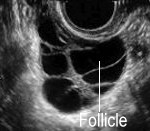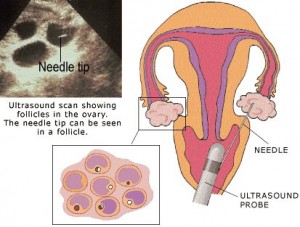Is Intracytoplasmic Sperm Injection (ICSI) ethical according to the teachings of the Catholic Church?
First, the ICSI procedure needs to be explained.
ICSI – Intracytoplasmic sperm Injection
ICSI or Intracytoplasmic sperm Injection is offered to a couple when the semen sample does not fall within ‘normal’ parameters. This can be due to:
- Oligozoospermia – Low number of sperm in the ejaculate
- Athenzoospermia – Poor progression or movement of the sperm
- Teratzoospemia – High numbers of abnormally formed sperm
Other couples that might be offered ICSI are those who have unexplained fertility, who have had an IVF cycle which has resulted in low or no fertilisation.
ICSI Treatment Stage 1
The first stage of treatment involves taking a nasal spray or subcutaneous injection of GnRH or Gonandotrophin releasing Hormone analogue. This drug temporarily stops the normal activity of the ovary so that ovulation does not occur when the ovaries are being stimulated. It shuts down the ‘normal’ ovarian function. Some women may experience side effects from the nasal spray or injection. These can be headaches, hot flushes or mood swings. The symptoms can be similar to that of PMT. The nasal spray or injection is taken for approximately two weeks. An ultra sound scan will then be performed to ensure that the ovaries are inactive.
ICSI Treatment Stage 2
Following the scan and confirmation that the nasal spray or injection has worked, the second drug will be introduced. These are administered by subcutaneous injection. These drugs are known as FSH or Follicle Stimulating Hormones. These will be administered on a daily basis and a scan will
be scheduled between D6-D9 to check the response. FSH stimulates the ovaries to produce multiple follicles. The progress will be assessed by ultra sound scans. There can also be some side effects with these drugs such as tiredness, feeling bloated or breast tenderness.
ICSI Treatment Stage 3
The scan will be checking the response to the FSH injections. The follicles will be counted and measured. When the follicles are a certain size approximately 18mm, this indicates that there may be a mature egg present (unfortunately not all follicles will contain eggs). At this stage, depending on the number and size of the follicles will determine when the egg collection will be scheduled. If the ovaries have responded well to the FSH injections then another injection called HCG or Human Chorionic Gonadotrophin will be advised to be administered. This injection helps to mature the eggs present and to release the eggs in the follicles for the egg collection. It is advised that this injection is taken approximately 36 hours prior to the scheduled procedure. Normally after this injection all other drugs are stopped.
ICSI Treatment Stage 4- The Egg Collection
The egg collection or oocyte retrieval can be performed either under General Anaesthetic or sedation. It involves a vaginal probe, similar to the one that have been used in the vaginal scans, with a needle guide attached to it. The needle then, under ultra sound guidance, is passed through the vaginal wall into each ovary. The follicles are then individually drained and an embryologist checks the follicular fluid for eggs.
It is in the laboratory following egg collection that it differs. Instead of the sperm being placed with an egg for natural fertilisation to occur, ICSI involves a selected single sperm injected directly into a mature egg. The eggs will then be placed in an incubator and checked the following day for fertilisation rates. The embryos are checked on day 2/3 of development. If they are progressing as expected then it may be recommended to aim for a blastocyst transfer on day 5. This can increase chances of a pregnancy.
ICSI Treatment Stage 5-Embryo Replacement
It is at the embryo transfer that the discussion of the number of and quality of embryos to be replaced will take place. The embryo replacement normally takes place with no sedation. It is similar to a smear test in that a speculum is passed into the vagina. The vagina is then cleaned whilst the embryologist loads the catheter containing the embryos. A fine caterer containing the embryo/ embryos is passed through the cervix and into the uterus. The embryo’s are deposited in the uterus. This is performed under ultra sound guidance. A pregnancy test should be performed 14 days after Embryo transfer.
Ethical Analysis:
According to Instruction Dignitas Personae : On Certain Bioethical Questions issued by the Congregation for the Doctrine of the Church:
17. Among the recent techniques of artificial fertilization which have gradually assumed a particular importance is intracytoplasmic sperm injection.[32] This technique is used with increasing frequency given its effectiveness in overcoming various forms of male infertility.[33]
Just as in general with in vitro fertilization, of which it is a variety, ICSI is intrinsically illicit: it causes a complete separation between procreation and the conjugal act. Indeed ICSI takes place “outside the bodies of the couple through actions of third parties whose competence and technical activity determine the success of the procedure. Such fertilization entrusts the life and identity of the embryo into the power of doctors and biologists and establishes the domination of technology over the origin and destiny of the human person. Such a relationship of domination is in itself contrary to the dignity and equality that must be common to parents and children. Conception in vitro is the result of the technical action which presides over fertilization. Such fertilization is neither in fact achieved nor positively willed as the expression and fruit of a specific act of the conjugal union”.[34]
[32] Intracytoplasmic sperm injection is similar in almost every respect to other forms of in vitro fertilization with the difference that in this procedure fertilization in the test tube does not take place on its own, but rather by means of the injection into the oocyte of a single sperm, selected earlier, or by the injection of immature germ cells taken from the man.
[33] There is ongoing discussion among specialists regarding the health risks which this method may pose for children conceived in this way.
[34] Congregation for the Doctrine of the Faith, Instruction Donum vitae, II, B, 5: AAS 80 (1988), 93.


